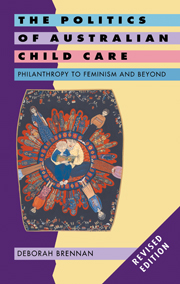Book contents
- Frontmatter
- Contents
- List of tables
- Acknowledgements
- List of abbreviations
- Preface to the Revised Edition
- Introduction: Women, the State and the Politics of Caring for Children
- 1 The Kindergarten Movement and Urban Social Reform
- 2 For the Sake of the Nation
- 3 A Mother's Place …?
- 4 Hitching Child Care to the Commonwealth Star
- 5 Playing Beneath the Sword of Damocles
- 6 For Love and Money
- 7 Child Care – an Industrial Issue
- 8 New Players, New Rules
- 9 Equity and Economics
- 10 The Market Rules … OK?
- References
- Index
1 - The Kindergarten Movement and Urban Social Reform
Published online by Cambridge University Press: 26 January 2010
- Frontmatter
- Contents
- List of tables
- Acknowledgements
- List of abbreviations
- Preface to the Revised Edition
- Introduction: Women, the State and the Politics of Caring for Children
- 1 The Kindergarten Movement and Urban Social Reform
- 2 For the Sake of the Nation
- 3 A Mother's Place …?
- 4 Hitching Child Care to the Commonwealth Star
- 5 Playing Beneath the Sword of Damocles
- 6 For Love and Money
- 7 Child Care – an Industrial Issue
- 8 New Players, New Rules
- 9 Equity and Economics
- 10 The Market Rules … OK?
- References
- Index
Summary
The Kindergarten Union stands for Formation, not Reformation, and if there were more Kindergartens and Playgrounds, there would be fewer gaols, fewer reformatories, fewer hospitals.
Kindergarten Union of NSW, Annual Report, 1923The kindergarten movement in Australia emerged during the last decade of the nineteenth century and was firmly based in the tradition of women's charitable work. The late nineteenth century was a period of extensive philanthropic activity, much of it aimed at reforming working class family life and improving the living conditions of the inner-city poor. Reformers of the period established organisations which focused on such diverse areas as slum abolition, town planning, municipal playgrounds, child health and national parks. Governments, too, increasingly became involved in the regulation of family life and in areas hitherto regarded as ‘private’ (Sydney Labour History Group 1982). Between the 1880s and the 1930s state and federal governments passed laws concerning compulsory attendance at school, the care of neglected and delinquent children, divorce, the age of consent and child labour.
Kerreen Reiger, author of The Disenchantment of the Home: Modernizing the Australian Family 1880-1940, has described these years as ‘a major formative period in modern Australian society’.
- Type
- Chapter
- Information
- The Politics of Australian Child CarePhilanthropy to Feminism and Beyond, pp. 13 - 31Publisher: Cambridge University PressPrint publication year: 1998



